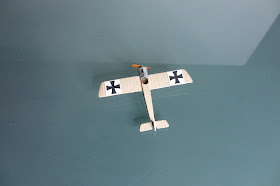Revenir à l'époque où voler c'était ressentir le froid de l’altitude malgré la peau de bête, entendre le bruit saccadé du moteur, sentir l’huile qui coule partout, ressentir la carcasse de l’avion grincer et craquer comme un bateau dans la tempête, en espérant que la toile résiste !
Revenir à l'époque où pour voler, il ne fallait pas être ingénieur en aéronautique, mais « avoir les couilles et la tête dans le ciel » !
Pour illustrer ces propos, retour sur un modèle emblématique du début de la première guerre mondiale : le Fokker E.III, premier avion de série à avoir une mitrailleuse synchronisée avec les hélices, ce qui a fait de lui le "fléau Fokker".
And if we changed ?
To return in the days when flying was feeling the cold altitude despite the animal's skin, hear the staccato sound of the engine, smell the oil flowing everywhere, feel the carcass of the plane squeak and creak like a ship in a storm, hoping that the fabric resists !
To return in the days when to fly, it should not be an aeronautical engineer, but "have the balls and head to the sky !".
To illustrate this, a return to the emblematic model of the beginning of the First World War, the Fokker E.III, the first production aircraft to have a synchronized machine gun with the propellers, which makes him the "Fokker scourge".
Le modèle présenté ici au 1/144 est le kit Skytrex, que j'ai monté, décoré et peint sans ajout de pièces, car à l'époque, le kit Reviresco n'était pas encore sorti.
The model presented here at 1/144 is Skytrex kit that I assembled, decorated and painted without adding parts, because at the time, the Reviresco kit was not released yet.
Une précision : si je reproche souvent les gravures trop fortes de certains modèles des fabricants industriels, j'ai fait le choix contraire pour les avions de la première guerre mondiale.
J'ai conservé ou donné un effet ondulé aux ailes, peut être excessif, pour marquer la différence de celles qui étaient recouvertes de toile sur une structure bois par rapport aux ailes "pleines" des années postérieures.
A precision : If I often criticized the excessive engravings of some models of industrial manufacturers, I made the opposite choice for aircraft of the First World War.
I have kept or given a rippled effect on the wings, may be excessive, to make the difference between those who were covered with fabric on a wooden structure compared to "full" wings of the later years.
1/144 Fokker E.III - Imperial German Army







Aucun commentaire:
Enregistrer un commentaire